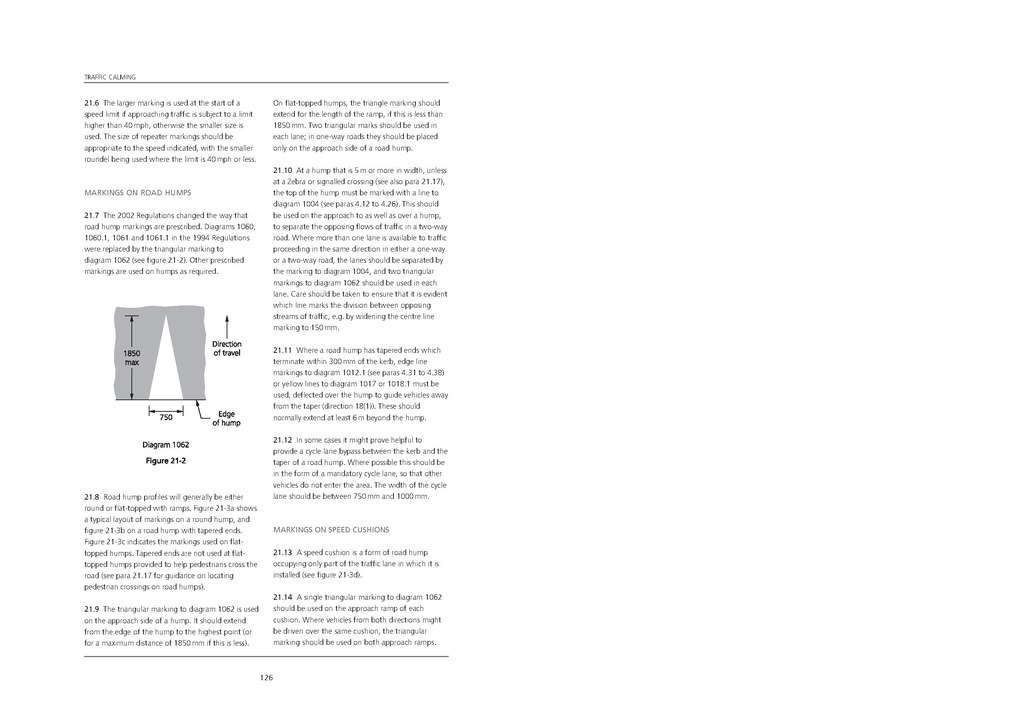21.6 The larger marking is used at the start of a speed limit if approaching traffic is subject to a limit higher than 40 mph, otherwise the smaller size is used. The size of repeater markings should be appropriate to the speed indicated, with the smaller roundel being used where the limit is 40 mph or less.

MARKINGS ON ROAD HUMPS
21.7 The 2002 Regulations changed the way that road hump markings are prescribed. Diagrams 1060, 1060.1, 1061 and 1061.1 in the 1994 Regulations were replaced by the triangular marking to diagram 1062 (see figure 21-2). Other prescribed markings are used on humps as required.
21.8 Road hump profiles will generally be either round or flat-topped with ramps. Figure 21-3a shows a typical layout of markings on a round hump, and figure 21-3b on a road hump with tapered ends. Figure 21-3c indicates the markings used on flat-topped humps. Tapered ends are not used at flat-topped humps provided to help pedestrians cross the road (see para 21.17 for guidance on locating pedestrian crossings on road humps).
21.9 The triangular marking to diagram 1062 is used on the approach side of a hump. It should extend from the edge of the hump to the highest point (or for a maximum distance of 1850 mm if this is less). On flat-topped humps, the triangle marking should extend for the length of the ramp, if this is less than 1850 mm. Two triangular marks should be used in each lane; in one-way roads they should be placed only on the approach side of a road hump.
MARKINGS ON SPEED CUSHIONS
21.10 At a hump that is 5 m or more in width, unless at a Zebra or signalled crossing (see also para 21.17), the top of the hump must be marked with a line to diagram 1004 (see paras 4.12 to 4.26). This should be used on the approach to as well as over a hump, to separate the opposing flows of traffic in a two-way road. Where more than one lane is available to traffic proceeding in the same direction in either a one-way or a two-way road, the lanes should be separated by the marking to diagram 1004, and two triangular markings to diagram 1062 should be used in each lane. Care should be taken to ensure that it is evident which line marks the division between opposing streams of traffic, e.g. by widening the centre line marking to 150 mm.
21.11 Where a road hump has tapered ends which terminate within 300 mm of the kerb, edge line markings to diagram 1012.1 (see paras 4.31 to 4.38) or yellow lines to diagram 1017 or 1018.1 must be used, deflected over the hump to guide vehicles away from the taper (direction 18(1)). These should normally extend at least 6 m beyond the hump.
21.12 In some cases it might prove helpful to provide a cycle lane bypass between the kerb and the taper of a road hump. Where possible this should be in the form of a mandatory cycle lane, so that other vehicles do not enter the area. The width of the cycle lane should be between 750 mm and 1000 mm.
MARKINGS ON SPEED CUSHIONS
21.13 A speed cushion is a form of road hump occupying only part of the traffic lane in which it is installed (see figure 21-3d).
21.14 A single triangular marking to diagram 1062 should be used on the approach ramp of each cushion. Where vehicles from both directions might be driven over the same cushion, the triangular marking should be used on both approach ramps.
126
